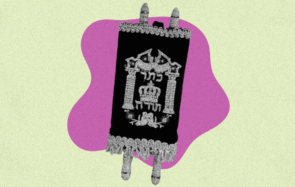A baby boy is born, and immediately you’re swamped with an endless number of things to do: Notify family and friends, prepare a nursery, find a mohel, and gather the strength to actually show up to your son’s bris. But for some Jewish parents, the work isn’t quite done after that eighth-day tradition. Jewish law asks parents of some baby boys to partake in yet another ceremony: a pidyon haben.
Pidyon Ha-What?
Pidyon haben means “redemption of a son.” According to the Book of Exodus, during the tenth plague in Egypt, the firstborn sons of the Egyptians were all killed, but the firstborn sons of the Israelites were spared. To commemorate this, Israelite firstborn sons were consecrated to divine service in the Temple.
However, for a variety of reasons over time, Temple service became the domain of Levites and Kohanim (the two Jewish priestly orders). This meant that regular Israelite firstborn sons were off the hook. Sort of.
In order to fully absolve their sons from the obligation to perform Temple service, parents were required to give money to a Kohen (also spelled “Cohen” in English) and thus buy back (“redeem”) their little boys.
Though the Temple no longer stands, according to Jewish law the claim on firstborn sons still exists, and therefore parents have the obligation to do this kind of redemption, through the pidyon haben ceremony.
Who Needs a Pidyon Haben?
A pidyon haben ceremony is only required for a male firstborn who is, in the words of the Bible, “the opening of his mother’s womb.” If the mother previously had a miscarriage after 40 days of pregnancy, her womb is considered already opened, and no pidyon haben is necessary when she gives birth to her first living son.
Additionally, firstborn sons born by caesarian section do not require a pidyon haben (in this case, Jewish law seems to concur with Shakespeare that a baby not born vaginally is not “of woman born”).
Since the obligation to work in the Temple only applied to sons of regular Israelites, if either parent is a descendant of Kohanim or Levites, no pidyon haben is necessary. If you’re not sure if you come from a family of Kohanim/Levites, your parents or grandparents might know, or you might be able to find out by consulting the ketubot (Jewish wedding contracts) of your ancestors.
What Exactly is Involved in the Ceremony?
The actual ritual is pretty simple (especially compared to a bris!). To redeem your son, you’ll need the equivalent of five silver shekels, which Jewish law determines is about 4.4 ounces of pure silver. Many American Jews use five silver dollars (just make sure they’re pure silver) or try to get their hands on the special coins that the Bank of Israel mints for this ritual. You’ll also need a Kohen to give this money to. If you have a friend who you know is a Kohen, that makes it easy, or a rabbi can help direct you to a Kohen who’ll participate.
In traditional circles, on the 31st day of the child’s life (or shortly thereafter if that day is Shabbat or a holiday), the father brings the child to a Kohen and recites a formula, indicating that this is the Israelite mother’s firstborn son and he has come to redeem him as commanded in the Torah. The Kohen asks the father which he would rather have, the child or the five silver shekels which he must pay. The father states that he prefers the child to the money. Then he recites a blessing and hands over the coins. The Kohen holds the coins over the child and declares that the redemption price is accepted in place of the child. He then blesses the child and returns him to the custody of his family.
In more liberal circles, both parents take part in the redemption conversation (not just the father), and the redeeming Kohen might be a man or a woman (known as a Bat-Kohen).
Do People Really Do This?
In Orthodox communities, pidyon haben is pretty much universally observed. Conservative Judaism requires pidyon haben under the same circumstances as Orthodox Judaism, and many–but certainly not all–Conservative Jews observe the practice.
Reform and Reconstructionist Jews do not observe pidyon haben, in keeping with their belief that Temple-related rituals are no longer relevant and are inconsistent with egalitarian values.
I Think I Want to Do a Pidyon Haben. How Can I Make it Special?
One of the nice things about pidyon haben is its flexibility. You can make it a big party with lots of guests and food, or you can hold a private ceremony in your home or in a rabbi’s office.
You might want to incorporate various pidyon haben customs that have developed in different times and places. In the Middle Ages, it was common to carry the baby out to his pidyon haben on a silver platter. This might sound fun–or scary–to you.
Some Ashkenazic families surround the baby with sugar lumps (in the hope of good things to come) and garlic cloves (against evil spirits), and drape him with his mother’s gold jewelry. Persian Jewish mothers and Jewish women in Turkey have the custom of wearing their bridal veil at a son’s pidyon haben.
Today, some families use pidyon haben as a time to affirm their commitment to raise their child Jewishly. If this appeals to you, you can get creative about finding ways to make that affirmation to your family or community.







